Every year, more and more Canadians are choosing fresh-cut evergreens to cheer their homes for the holidays. Real trees are beautiful, fragrant, and studies show they are carbon-neutral and more environmentally sustainable than plastic trees. There are many different species of evergreen offered at Christmas tree farms around Ontario in November-December; each tree has its own unique beauty. This guide will help you choose the best tree for your family this festive season.
First, it helps to know the three main types of Christmas tree available and how to tell them apart when you’re on the farm cutting your own or choosing at a local vendor.
Pine, Fir, and Spruce
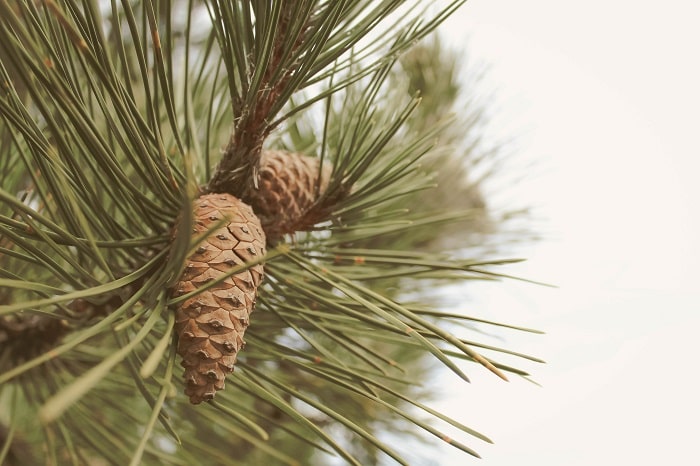
Pine needles
Pine trees have long, thin needles that grow in clusters. A useful mnemonic is: “Pine needles are like porcupine quills.”
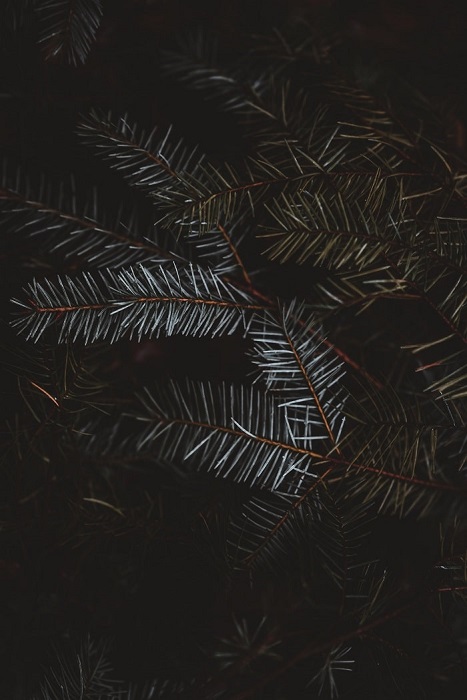
Fir needles
Fir needles are soft and flat. They are shorter and broader than most pine needles and grow independently. They tend to have two white stripes on the bottom of each needle. Mnemonic: “Fir needles are flat.”
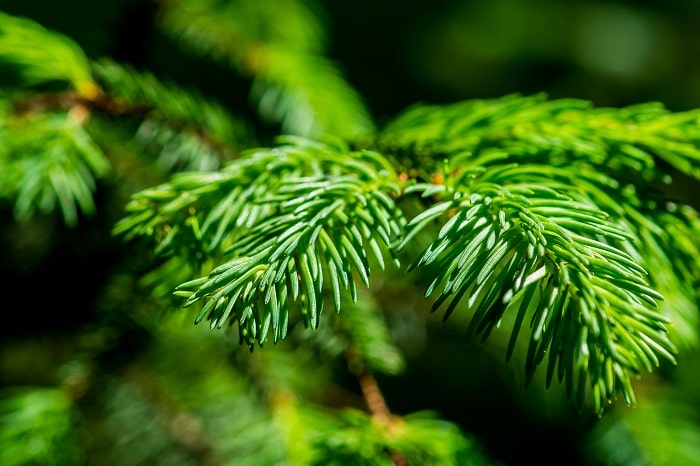
Spruce needles have four sides.
Spruce needles are short and grow singly like fir needles, but they usually have four sides and can be rolled between your fingers. Their needles often have sharp, pointy ends. Mnemonic: “Spruce needles are spiky.”
All three of these evergreens make excellent Christmas trees, but each type has different varieties, each with their own unique attributes.
Eastern White Pine
Eastern White Pine (Pinus strobus linnaeus)
The provincial tree of Ontario, the eastern white pine has long, feathery, blue-green needles that give it a delicate look. It has a very full, conical shape and it is generally wider than other pine trees on offer.
- Needles: 5-8 cm, in clusters of five
- Branches: soft and flexible — not recommended for heavy ornaments
- Fragrance: very mild — the best choice for people with allergies
- Needle Retention: good to excellent
Scots Pine
Scots/Scotch Pine (Pinus sylvestris)
The Scots pine is the most popular Christmas tree in Canada — with good reason — it has an excellent conical shape, dense foliage, and bright green colouring.
- Needles: 4-7 cm, in clusters of two, usually twisted with sharp ends
- Branches: stiff — good for supporting heavy ornaments and lights
- Fragrance: strong, beautiful aroma
- Needle Retention: best of the pines — even if the tree dries out, needles stay attached
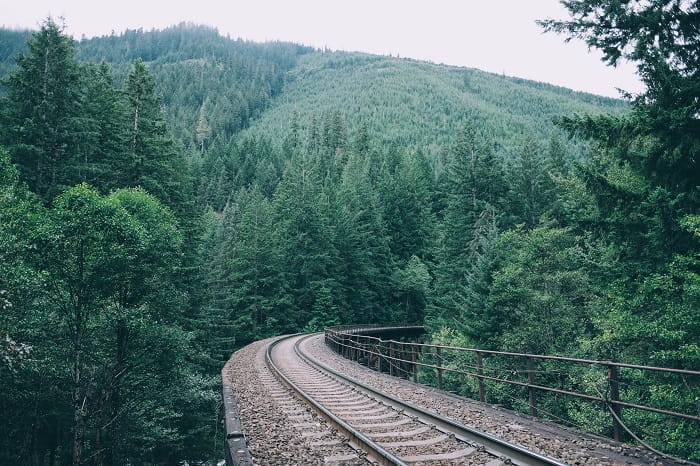
Red/Norway Pine
Red/Norway Pine (Pinus resinosa)
The red or Norway Pine is dark green with a big, bushy shape. It is gradually increasing in popularity in Ontario.
- Needles: 8-16cm, very long and brittle, clusters of two
- Branches: strong — can support heavy decorations
- Fragrance: good
- Needle Retention: very good
Spruce Trees
Spruce trees generally have the strongest branches for holding ornaments but the worst needle retention of all the trees available.
Colorado Blue Spruce
Colorado Blue Spruce (Picea Pungens)
The Colorado blue spruce is dark green to powdery blue, with a narrow, symmetrical, conical shape. It’s a beautiful tree, but beware of its sharp needles—it gets its Latin name of “pungens” from its ability to puncture the skin.
- Needles: 15-30 mm, short, stiff, and sharp
- Branches: very stiff — can support heavy decorations
- Fragrance: very pungent when needles are crushed
- Needle Retention: will drop its needles in a warm room but is the best of the spruce varieties for needle retention
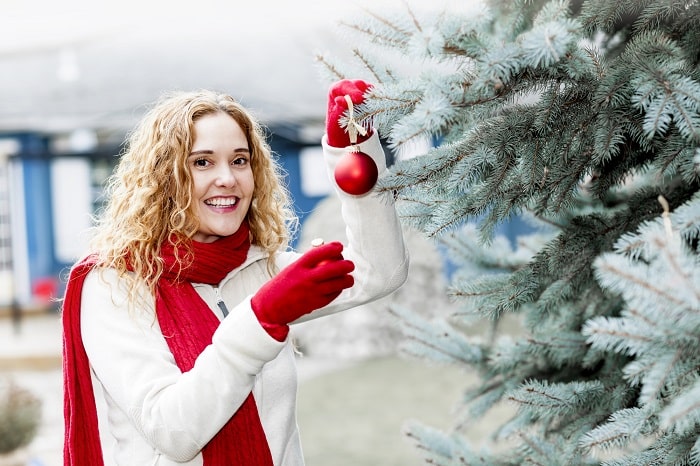
White Spruce
White Spruce (Picea Glauca)
The white spruce is a conical, nicely symmetrical tree with dark green or bluish dense foliage.
- Needles: 1.5-2.2 cm, stiff with a blunt tip
- Branches: strong and slender — hold ornaments well
- Fragrance: strong, pungent odour when needles are crushed
- Needle Retention: must be watered consistently for good needle retention
Norway Spruce
Norway spruce (Picea abies)
A traditional European Christmas tree, the Norway spruce is now gaining popularity in Canada. It has dark green needles, a conical shape, and drooping branches.
- Needles: 1.75-2.5 cm, smooth and stiff with a pointed tip
- Branches: strong and slender — hold ornaments well
- Fragrance: rich, sweet scent
- Needle Retention: poor, unless the trees are cut fresh and watered consistently
Fir Trees
Fir trees are often the most expensive of the evergreens because they take the longest to grow or must be imported. Many consider them worth the expense because of the beautiful shape and fragrance. They also have the best needle retention of all the Christmas trees.
Fraser Fir
Fraser Fir (Abies fraseri)
This fir is native to the Appalachians but ships well, so most Fraser firs available in Ontario are pre-cut and imported. That said, due to the tree’s popularity, some farms are now growing them locally. The tree is conical and symmetrical with slightly upturned branches, giving it a compact look.
- Needles: 1-2.5 cm, flat, dark blue-green on top with a silver underside
- Branches: sturdy, slightly upturned — hold ornaments well.
- Fragrance: pleasant scent, less aromatic than the Balsam Fir
- Needle Retention: outstanding, but known to be a very thirsty tree
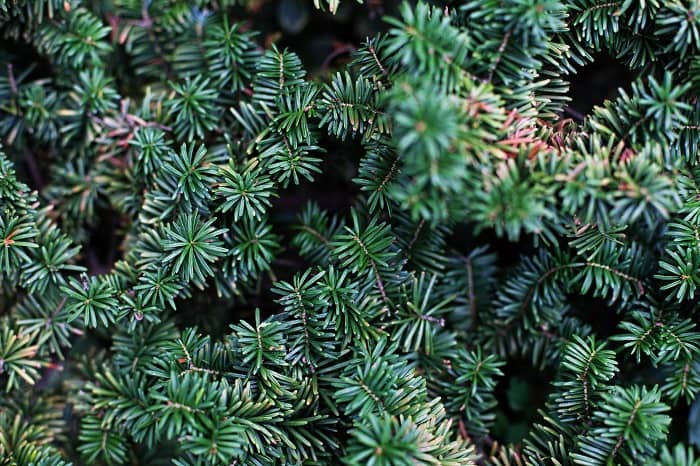
Balsam Fir
Balsam Fir (Abies balsamea)
The balsam fir is very similar to the Fraser fir — in fact, they derive from the same species. However, the balsam fir is native to Canada so it is more widely available here as a cut-your-own tree. The tree is conical, relatively dense and has a distinctive spire-like tip.
- Needles: 2-4 cm, short and flat with a round tip; shiny, dark green on top with white bands underneath
- Branches: sturdy, but more flexible than the Fraser fir; bark is always sticky with resin.
- Fragrance: excellent
- Needle Retention: excellent
Canaan Fir
Canaan Fir (Abies balsamea ‘var. phanerolepis’)
Often considered a combination of the Fraser and balsam firs, The Canaan fir is not widely available in Ontario yet, but it is gaining popularity. The Canaan is actually a variety of the balsam, sharing its shape and densit. It is a more resilient tree and easier to grow.
- Needles: 2-4 cm, more varied in colour than the balsam fir
- Branches: strong
- Fragrance: excellent
- Needle Retention: outstanding
No matter which tree you select, the secret to keeping it looking beautiful throughout the holiday season is a little bit of “TLC.”
Care and Maintenance
- Make a fresh cut – A few days after a tree is cut, it will excrete a resin seal to maximize water retention. This means that after that seal is created any water you give your tree won’t be absorbed. So, if you buy a pre-cut tree or take a few days to place it in a stand, be sure to saw about 10 cm off the end just before you set up the tree in your home (or elsewhere). While you have the saw out, it’s a good idea to also cut some of the lower branches off the tree.
- A strong stand – Be sure to use a sturdy tree stand. Metal is best, with four legs and at least three strong screws to hold the trunk in place. If your stand doesn’t have a container for water, set your tree in a bucket or large bowl.
- Location – When deciding where to place your tree indoors, consider the location of heaters and vents. If you can keep your tree in a cool place, it will reward you by staying fresher longer.
- Watering – The best way to extend the life of your Christmas tree is to hydrate it. Studies have shown that adding ingredients like sugar, aspirin or vodka don’t help — plain tap water is best for needle retention. Trees are thirstiest directly after they’ve been cut. Be sure to check your water level twice a day for the first few days — you’ll be amazed by how quickly a tree will drink. After that, water consumption will taper off steeply and you need only check every 1-2 days.
Now that you’re armed with everything you need to know to get your perfect tree this season, all that’s left is to find it.
If you’re short on time, there are a number of local options for pre-cut trees and many donate their profits to charity. Be sure to check for freshness by giving the trees a shake to gauge needle retention and remember to cut the ends off the stumps at the vendor or when you’re home.
Pre-cut Trees
- Downtown Barrie hosts a Christmas Tree Lot and Market with proceeds going to Hospice Simcoe—every Saturday from November 24th to December 15th, 11 am–5 pm.
- The Kiwanis Club is selling trees starting November 23rd at Roberts No Frills parking lot in Barrie.
- The Thornbury Beaver Valley Lions Club sells trees at the Thornbury Chamber of Commerce Building starting in December.
Cut-Your-Own
If you want the full experience of chopping down your own tree, there are many excellent tree farms in York Region and Simcoe County.
Dryesdale’s Tree Farm in Egbert offers cut-your-own Fraser firs, balsam firs, and spruce as well as pre-cut Fraser firs. They also have a beautiful Christmas Village complete with live entertainment, a bonfire with marshmallow roasting, horse-drawn carriage rides, face painting and visits with Santa—weekends from November 17-December 23.
Horton’s Magic Hill Tree Farm north of Stouffville offers white spruce, white pine, blue spruce (limited quantity), and balsam fir (limited quantity). No pre-cut trees this year. They also offer refreshments and snacks, wagon rides, a sandpit playground, a bonfire, and tobogganing (bring your own).
Hockley Valley Farm in Mono have cut-your-own spruce and pre-cut fir. They also offer horse-drawn wagon rides through the forest, nature trails with magnificent views of Hockley Valley, and a hot chocolate bar/bonfire with marshmallows. The festivities open November 24th.
Niemi Family Farm and Bakery in Mount Albert offer Fraser fir, balsam fir, and Scots pine. They have a bakery, wagon rides, hot chocolate, and a bonfire. They are open Monday–Saturday, Nov 23rd-Dec 22nd.
It’s always a good idea to call ahead to ensure your desired tree is available.
Now that you have a plan for your indoor tree, you might want to consider protecting the living trees on your property for winter. We have some great tips for helping your trees survive the harsh weather so they’re ready to bloom again in the spring.
Great Northern ReGreenery offers all the services you need to keep your trees healthy and strong. For tree inspection, removal, cabling and bracing in Bradford, Barrie, Alliston, Newmarket, and Aurora call us at (905) 775-7444. We also provide free inspection and assessment.





